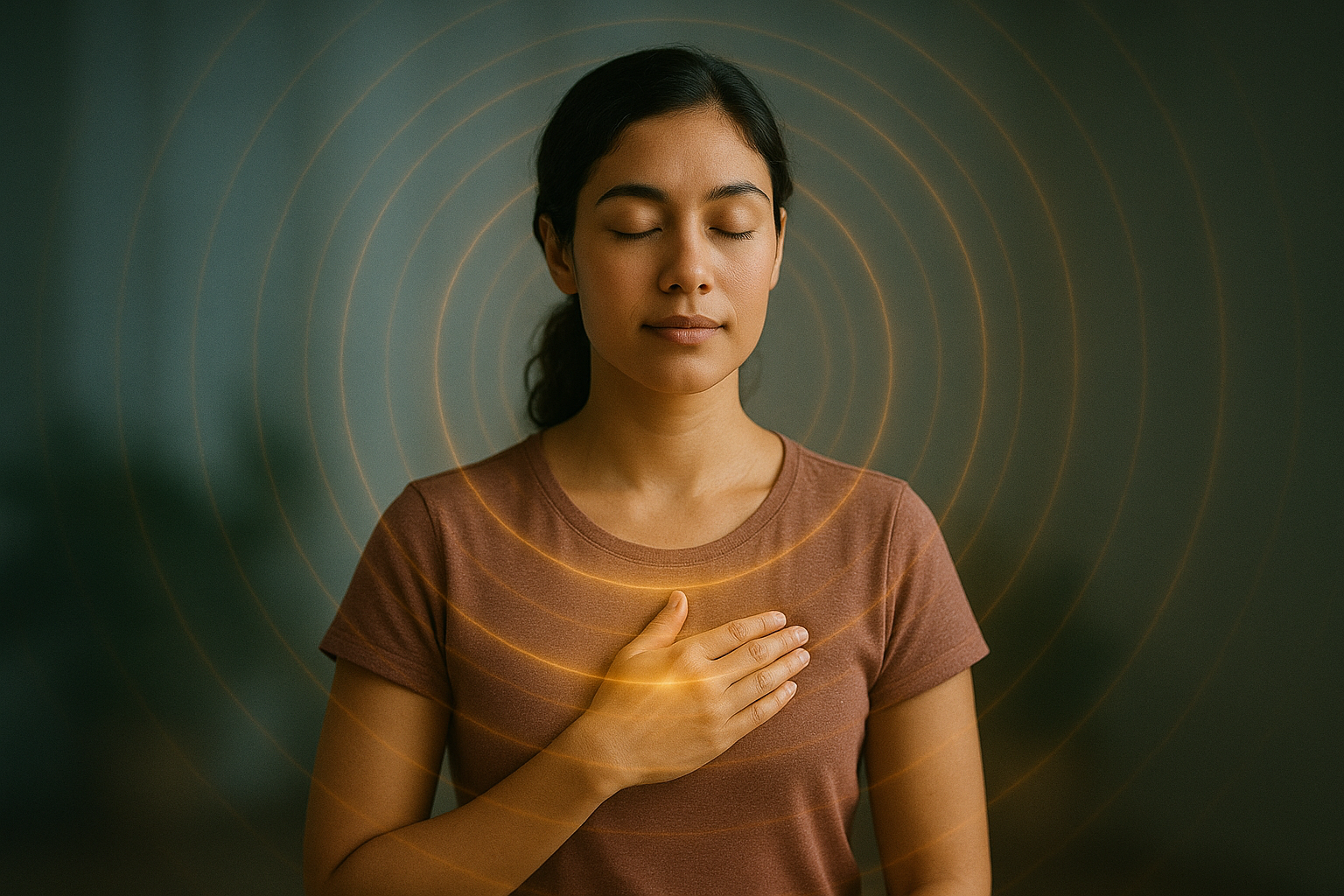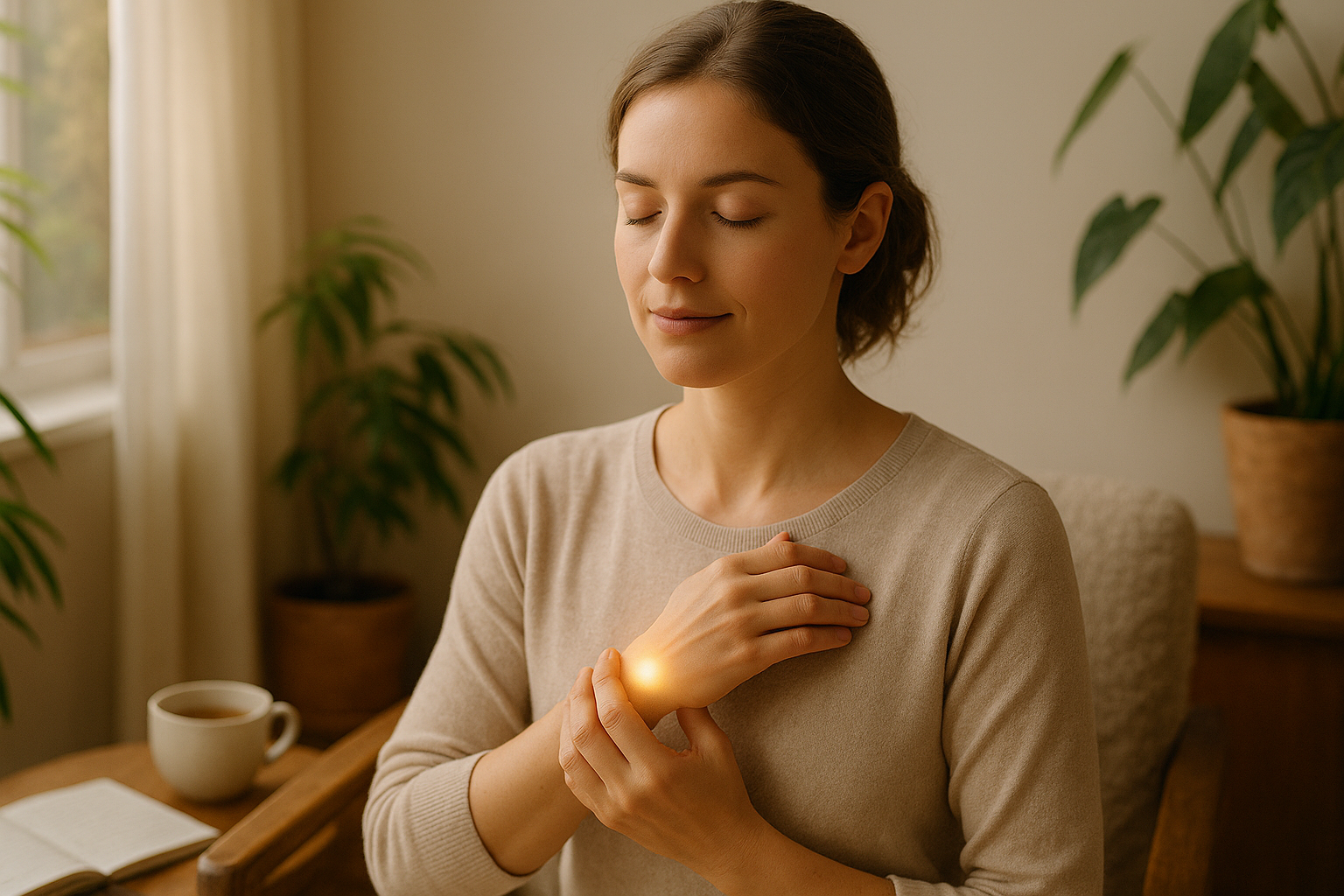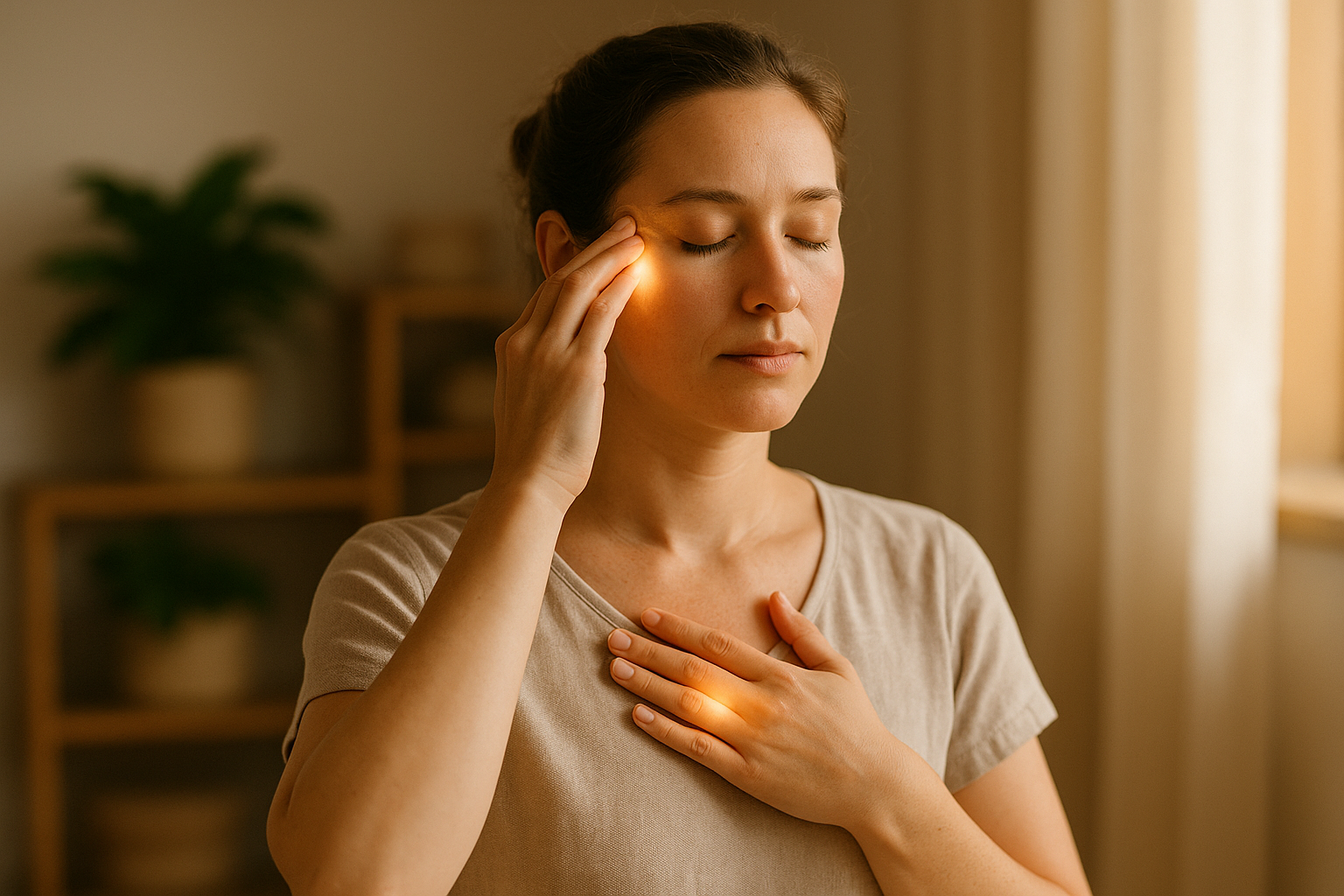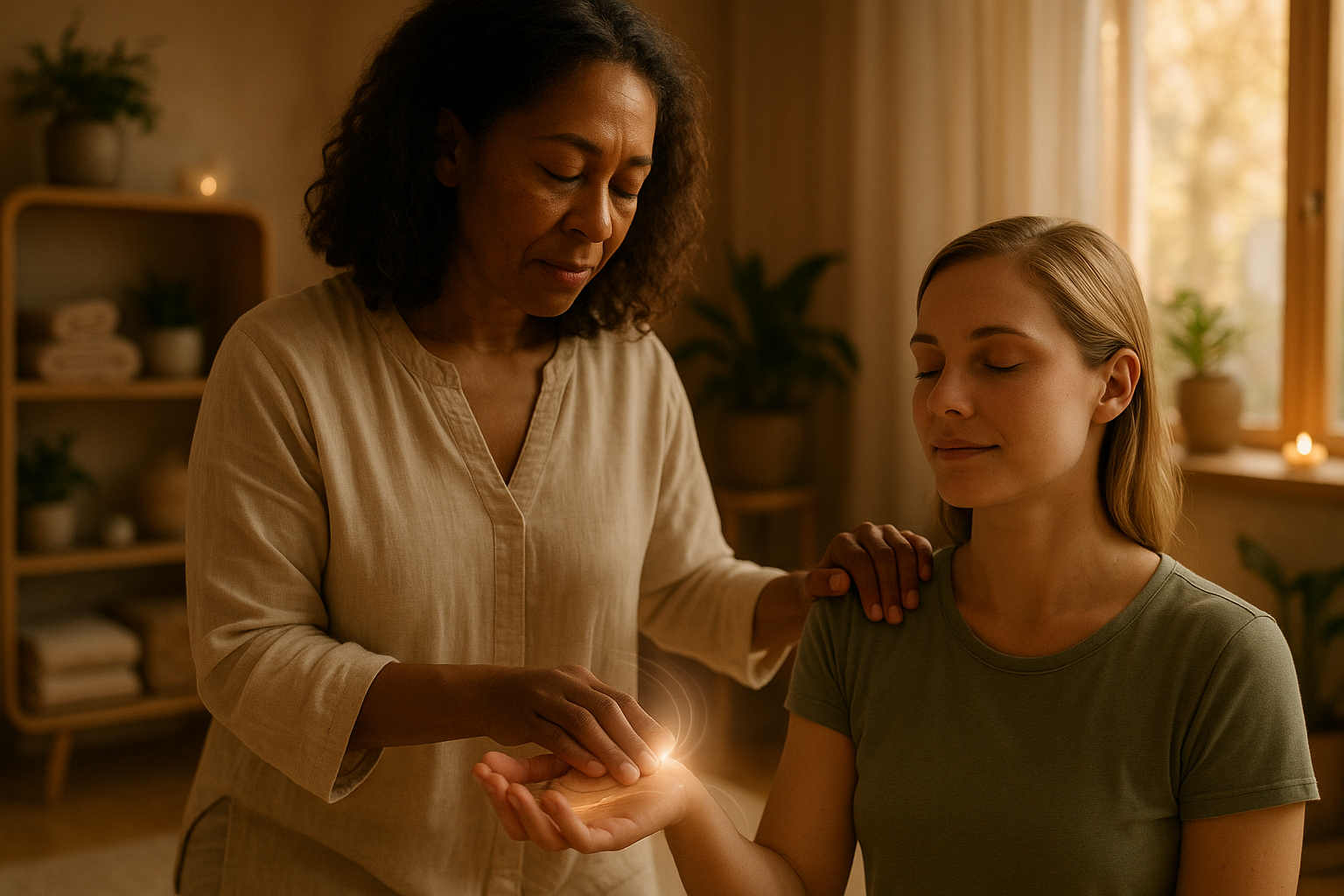Estimated Reading Time: 10–12 minutes
What You Will Learn
-
The science and philosophy behind presence — and why it’s essential for emotional well-being.
-
How acupressure supports mindfulness and self-connection through body awareness.
-
Step-by-step guidance for using acupressure to ground yourself during stress or disconnection.
-
Practical daily rituals that merge touch, breath, and attention to build inner peace.
-
Reflections on how presence transforms your relationship with yourself and others.
1. The Lost Art of Presence
 Presence is more than simply being “in the moment.” It’s the felt sense of fully inhabiting your life — aware of your sensations, emotions, and environment without being consumed by them. Yet, in a culture that prizes speed, productivity, and distraction, this embodied awareness has become increasingly rare.
Presence is more than simply being “in the moment.” It’s the felt sense of fully inhabiting your life — aware of your sensations, emotions, and environment without being consumed by them. Yet, in a culture that prizes speed, productivity, and distraction, this embodied awareness has become increasingly rare.
According to Jon Kabat-Zinn, the founder of Mindfulness-Based Stress Reduction (MBSR), presence means “paying attention in a particular way: on purpose, in the present moment, and non-judgmentally.” When you cultivate presence, you don’t just quiet your mind — you strengthen the neural circuits responsible for emotional regulation, empathy, and resilience (Kabat-Zinn, 2013).
But here’s the challenge: most of us live from the neck up. We think, analyze, and plan — often at the cost of sensing and feeling. The body, though, holds a map to grounding, awareness, and healing. Acupressure offers a bridge back to that map.
2. Acupressure: A Pathway Back to the Body
Acupressure, a foundational technique in Traditional Chinese Medicine (TCM), involves applying gentle, sustained pressure to specific points along the body’s meridians — invisible energy pathways that influence physical and emotional balance.
For over 2,000 years, practitioners have used these points to ease tension, restore flow, and harmonize the body’s vital energy, or Qi (Qi, 2019).
Modern research supports these traditional insights. Studies have shown that acupressure can reduce stress, improve sleep quality, and lower anxiety by stimulating the parasympathetic nervous system — the body’s “rest and digest” response (Lee et al., 2021).
When practiced mindfully, acupressure becomes more than a physical technique — it becomes a meditative act of self-contact. Through touch, you reconnect with your breath, your sensations, and your inner world.
As Dr. Michael Reed Gach, author of Acupressure’s Potent Points, writes, “Touching your body consciously awakens your awareness, softens your resistance, and reestablishes your natural rhythm.”
3. The Science of Presence Through Touch
Touch is the first sense we develop, and it remains one of the most powerful regulators of our emotional state. Gentle pressure releases oxytocin — the “bonding hormone” — while lowering cortisol levels, the body’s primary stress hormone (Uvnäs-Moberg et al., 2015).
Acupressure enhances this soothing mechanism by combining physical stimulation with mindful awareness. When you focus your attention on the point you’re pressing, you shift from mental rumination to embodied sensing. This dual focus — physical and mental — activates the insula and prefrontal cortex, regions of the brain linked to interoception (inner body awareness) and emotional balance (Craig, 2009).
In other words, acupressure doesn’t just calm you — it helps you feel yourself again. It creates a feedback loop of awareness: you touch your body, your body responds, your mind notices the change, and presence deepens.
4. Why We Lose Connection — and How Touch Restores It
Disconnection from the self often happens quietly. You skip breaks, ignore your body’s signals, or distract yourself when uncomfortable emotions arise. Over time, this leads to emotional numbness, tension, and fatigue.
Acupressure reverses this pattern by bringing awareness directly to where disconnection lives — in the body. Through touch, you begin to listen again:
-
Where do I feel tightness or heaviness?
-
What happens when I breathe into that space?
-
What emotions surface when I stay with this sensation?
This gentle self-inquiry turns touch into communication. You’re not fixing your body — you’re listening to it. And that listening is the essence of presence.
5. Three Acupressure Points to Cultivate Presence
Below are three simple, research-backed acupressure points you can use to ground yourself and reconnect with your body. You can practice these anytime — during a work break, before sleep, or whenever you feel scattered.
1. Heart 7 (Shenmen — “Spirit Gate”)
Location: On the wrist crease, at the base of the little finger, where the hand meets the forearm.
How to apply: Use the thumb of your opposite hand to press gently for 1–2 minutes while breathing slowly.
Benefits: Calms anxiety, quiets the mind, and fosters emotional balance.
This point is often called the “Spirit Gate” because it opens the door to your inner calm. Focusing here while breathing deeply can ease agitation and restore emotional harmony (Huang & Cheng, 2018).
2. Pericardium 6 (Neiguan — “Inner Gate”)
Location: About three finger widths below the wrist crease, between the two tendons in the center of the forearm.
How to apply: Press gently with your thumb while keeping your forearm relaxed.
Benefits: Reduces anxiety, nausea, and emotional restlessness.
In TCM, the Pericardium protects the heart from emotional shock. Activating Neiguan helps release tension held around the chest and stomach — places where many people carry anxiety. It’s also a powerful point for motion sickness and emotional turbulence (Yim et al., 2019).
3. Kidney 1 (Yongquan — “Gushing Spring”)
Location: On the sole of the foot, about one-third of the way down from the toes to the heel, in the soft depression that forms when you flex your toes.
How to apply: Use your thumb or a soft massage ball to apply gentle pressure for 1–2 minutes on each foot.
Benefits: Grounds scattered energy, calms overthinking, and helps you feel anchored in your body.
Kidney 1 connects you to the Earth element — symbolizing rootedness and vitality. When you feel ungrounded or mentally overactive, stimulating this point helps bring awareness back down from the head into the body.
6. Turning Acupressure into a Presence Ritual
Acupressure becomes most powerful when paired with intentional awareness. Below is a simple three-step ritual to help you integrate presence into your day.
 Step 1: Pause and Sense
Step 1: Pause and Sense
Before beginning, close your eyes and take a few slow breaths. Notice your posture, your heartbeat, and any areas of tension. This moment of noticing sets the foundation for presence.
Step 2: Press and Breathe
Choose one point — such as Heart 7 or Pericardium 6 — and apply gentle, steady pressure. Inhale through your nose, exhale slowly through your mouth. Imagine your breath flowing through the point. Stay here for 1–2 minutes, maintaining awareness of both your touch and breath.
Step 3: Reflect and Re-enter
After releasing the point, observe any sensations or emotions that arise. Don’t analyze — just notice. Carry this mindful awareness with you as you return to your activity.
Practiced daily, this simple ritual retrains your nervous system to find calm within motion and presence within busyness.
7. How Presence Transforms Emotional Well-Being
When you learn to return to the present moment through your body, you reclaim power over your inner state. Presence reduces reactivity, increases emotional clarity, and enhances self-compassion — qualities central to psychological resilience (Reivich & Shatté, 2002).
Presence also nurtures self-trust. As you tune into your body’s signals, you begin to rely on your own wisdom rather than external validation. This deep self-attunement fosters authenticity and grounded confidence.
From a physiological perspective, consistent mindfulness-based body practices like acupressure improve vagal tone — the flexibility of your parasympathetic nervous system to respond to stress — leading to lower heart rate variability and faster recovery from emotional arousal (Porges, 2011).
In essence, presence rebalances both the mind and the body — turning inner noise into inner knowing.
8. Integrating Acupressure into Modern Life
You don’t need an elaborate setting to practice acupressure. In fact, the beauty of this practice lies in its simplicity and accessibility. Here are practical ways to bring presence through acupressure into daily life:
-
Morning grounding: Before checking your phone, take two minutes to press Kidney 1 on each foot and breathe deeply. This anchors your energy for the day.
-
Midday reset: During work breaks, apply Pericardium 6 to release tension from mental fatigue.
-
Evening unwind: Press Heart 7 before sleep to transition from activity to rest.
-
Emotional overwhelm: When anxious thoughts rise, use your breath and touch to “find your pulse.” This gesture reminds your body that you are safe.
-
Mindful transitions: Practice acupressure between meetings, after a call, or before a meal. Small rituals reinforce self-connection throughout the day.
These micro-moments of embodied attention turn ordinary routines into touchpoints of peace.
9. Presence, Self-Compassion, and the Art of Letting Be
Presence isn’t about controlling your experience — it’s about allowing it. When you combine acupressure with mindful awareness, you practice what psychologist Kristin Neff calls self-compassion — treating yourself with warmth and acceptance rather than criticism (Neff, 2011).
Pressing a point on your wrist, you might feel tension, sadness, or fatigue. Instead of resisting it, you simply notice and breathe. This act of gentle noticing communicates to your nervous system that it’s okay to feel, to soften, to release.
Presence becomes compassion in action — a touch that says, “I’m here with you.”
10. From Technique to Transformation
Many people begin acupressure for symptom relief — stress, insomnia, or anxiety. But those who stay with the practice often discover something deeper: a renewed relationship with themselves.
When you touch your body with awareness, you begin to inhabit it differently. You slow down, listen, and respond with kindness. This process rekindles a sense of belonging within your own skin.
As mindfulness teacher Thich Nhat Hanh once wrote, “When you touch one thing with deep awareness, you touch everything.”
Each acupressure point becomes an invitation to pause — to return to yourself, again and again.
11. Bringing It All Together
Presence isn’t found in grand moments of stillness — it’s cultivated in the quiet spaces between breaths, in the simple act of pressing your hand to your heart, in remembering that your body is not separate from your mind.
Acupressure is both a method and a metaphor: by pressing the body, you awaken its wisdom; by slowing down, you hear what’s been whispering all along.
In an age of constant distraction, this ancient art offers a radical reminder — that the most profound healing often begins with one mindful touch.
12. A 5-Minute Daily Practice to Reconnect 
1. Find your seat. Sit comfortably with both feet on the floor.
2. Breathe. Inhale slowly through your nose for a count of four, exhale through your mouth for a count of six.
3. Apply pressure. Press Heart 7 on each wrist for one minute.
4. Anchor awareness. Move to Kidney 1 on each foot, feeling the connection with the ground.
5. Reflect. Ask yourself gently, “How am I right now?”
Repeat daily. Over time, these five minutes cultivate a powerful inner steadiness — the kind that transforms how you meet life.
13. Final Reflection: The Power of Presence
To be present is to remember that you are already whole. Acupressure helps you experience that wholeness through the language of the body — subtle, steady, and wise.
Each point you press is a reminder: calm isn’t something to chase; it’s something you return to, through awareness and touch.
In the rhythm of modern life, presence is both medicine and art — and your own hands hold the tools to practice it.
References
-
Craig, A. D. (2009). How do you feel—now? The anterior insula and human awareness. Nature Reviews Neuroscience, 10(1), 59–70.
-
Gach, M. R. (1990). Acupressure’s Potent Points: A Guide to Self-Care for Common Ailments. Bantam Books.
-
Huang, W., & Cheng, X. (2018). The effects of acupressure on anxiety: A meta-analysis. Journal of Alternative and Complementary Medicine, 24(5), 435–443.
-
Kabat-Zinn, J. (2013). Full Catastrophe Living: Using the Wisdom of Your Body and Mind to Face Stress, Pain, and Illness. Bantam Dell.
-
Lee, J., Kim, S., & Choi, J. (2021). Effects of self-acupressure on stress and sleep quality: A randomized controlled trial. Complementary Therapies in Medicine, 57, 102628.
-
Neff, K. (2011). Self-Compassion: The Proven Power of Being Kind to Yourself. William Morrow.
-
Porges, S. W. (2011). The Polyvagal Theory: Neurophysiological Foundations of Emotions, Attachment, Communication, and Self-Regulation. Norton.
-
Qi, F. (2019). Traditional Chinese Medicine and the concept of Qi: An integrative perspective. Chinese Journal of Integrative Medicine, 25(7), 563–569.
-
Reivich, K., & Shatté, A. (2002). The Resilience Factor: 7 Keys to Finding Your Inner Strength and Overcoming Life’s Hurdles. Broadway Books.
-
Uvnäs-Moberg, K., Handlin, L., & Petersson, M. (2015). Self-soothing behaviors with oxytocin release as a mechanism for stress reduction: Implications for acupressure. Frontiers in Psychology, 6, 1529.
-
Yim, J., Chung, H., & Lee, J. (2019). The effectiveness of Pericardium 6 (Neiguan) acupressure on anxiety and nausea: A systematic review. Complementary Therapies in Clinical Practice, 35, 145–152.





